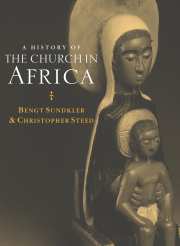Book contents
- Frontmatter
- Contents
- List of maps
- Acknowledgements
- List of abbreviations
- Introduction
- PART I THE FIRST FOURTEEN HUNDRED YEARS
- PART II THE MIDDLE AGES 1415 – 1787
- PART III THE LONG NINETEENTH CENTURY 1787 – 1919
- 3 Overview To The Nineteenth Century
- 4 North and North-Eastern Africa
- 5 Western Africa
- 6 West-Central Africa
- 7 Southern Africa
- 8 South-Central Africa and the Indian Ocean
- 9 East Africa
- 10 East-Central Africa
- PART IV THE COLONIAL EXPERIENCE 1920 – 1959
- PART V INDEPENDENT AFRICA 1960 – 92
- Notes
- Bibliography
- Name index
- Subject index
10 - East-Central Africa
from PART III - THE LONG NINETEENTH CENTURY 1787 – 1919
Published online by Cambridge University Press: 16 September 2009
- Frontmatter
- Contents
- List of maps
- Acknowledgements
- List of abbreviations
- Introduction
- PART I THE FIRST FOURTEEN HUNDRED YEARS
- PART II THE MIDDLE AGES 1415 – 1787
- PART III THE LONG NINETEENTH CENTURY 1787 – 1919
- 3 Overview To The Nineteenth Century
- 4 North and North-Eastern Africa
- 5 Western Africa
- 6 West-Central Africa
- 7 Southern Africa
- 8 South-Central Africa and the Indian Ocean
- 9 East Africa
- 10 East-Central Africa
- PART IV THE COLONIAL EXPERIENCE 1920 – 1959
- PART V INDEPENDENT AFRICA 1960 – 92
- Notes
- Bibliography
- Name index
- Subject index
Summary
THE CHURCH AT THE KINGS' WAY
The ‘Lacustrines’ – the ethnic communities in western Uganda, along Lake Victoria and Lake Tanganyika – are known because of certain ethnological distinctions between a royal and aristocratic upper class, a minority of some ten per cent of the population and the broad masses of the commoners, the cultivators. Further south, the Fipa and the Bemba fall into the same category. It is realized that the account could profitably have been stretched even further south to the Lozi in south-western Zambia, but there strong links of mission history with southern Africa suggest that this community be treated with the southerners.
Missiologically the entire region is characterized by an exclusive combination of, and competition between, Catholics, the White Fathers and low-church Anglicans (CMS). The exceptions to this pattern are the Congregationalist (LMS) attempt on Lake Tanganyika and further south in Bembaland with, on the Catholic side again the dominating presence of White Fathers, but where the Protestant party consists of Congregationalists and Presbyterians, the latter closely linked with Malawi's ‘Livingstonia’.
This structure – with its social tensions and missiological polarities – continued throughout the colonial period, in some places with feudal characteristics or those of a caste society, and together constituting a highly significant framework for the beginnings of a vital Christian Church.
Until about 1950 the ethnological differentiation was explained by a supposedly Hamitic population theory; according to which early invasions had come from somewhere north, Ethiopia or Egypt and the Middle East.
- Type
- Chapter
- Information
- A History of the Church in Africa , pp. 562 - 607Publisher: Cambridge University PressPrint publication year: 2000



